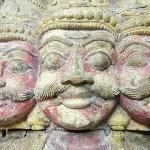| Object Number | 87-36-1 |
| Current Location | Collections Storage |
| Culture | Indian | Hindu |
| Provenience | India | Tripati Area |
| Period | Early Pandiyan Period |
| Date Made | 17th Century |
| Section | Asian |
| Materials | Wood | Paint | Metal | Gesso (uncertain) |
| Technique | Carved | Painted |
| Iconography | Ravana | Gada | Trishula | Ghanta |
| Description | Carved and painted wood statue of kneeling figure of Ravana, Hindu deity with nine heads and nineteen arms. Ravana is a giant figure in Indian mythology. He is often called the "Demon-King of Lanka", traditionally associated with the modern nation and island of Sri Lanka. Taking the evil-genius theme, Indian story tellers created a persona who is said to have been as smart and strong as ten men. This is why he is often portrayed with ten heads and twenty arms. This wooden statue is representative of south Indian portrayals of Ravana. If you count the heads there are only nine. The Indian artist elected to sacrifice the literal notion of ten heads in favor of symmetry, with a central head evenly flanked by four others. Orginially there were twenty arms. The skin of the figure is painted red with yellow paint on the short, lower, garment and ornamentation which includes crowns, earrings, necklaces, arm bands, anklets. Right arms: 1) Far right palm open supporting heads; 2) In front of right side of chest with palm open and upward; 3) Above right knee holding Khadga (sword); 4) Lowered hand grasping object which is currently missing, probably for Gada (club); 5) Downward with palm open and facing down; 6) Lowered holding Shula (spear); 7) To front holding Naga (snake); 8) Front and upward holding handle with top broken off, probably for Trishula (trident); 9) Upward holding Vajra (bolt of lightening); 10)Straight to right side holding Ghanta (bell). Left arms: 1) Far left and back palm open as if to support heads; 2) In front of chest with palm open and upward; 3) In front of body at waist level holding musical instrument with hand-like end; 4) Downward with palm open and facing down; 5) Lowered holding Khetaka (shield); 6) To front holding Gada (club); 7) Raised holding Ankusha(hook); 8) Raised holding Pasha (lasso); 9) Raised holding curved end, possibly Padma (lotus) but piece is missing. |
| Height | 162.5 cm |
| Length | 140 cm |
| Width | 104 cm |
| Credit Line | Gift of Sonia C. Jaipaul-Wardlaw and Rosita Jaipaul, in honor of their parents Dr. and Mrs. Jaipaul, 1987 |
Report problems and issues to digitalmedia@pennmuseum.org.




